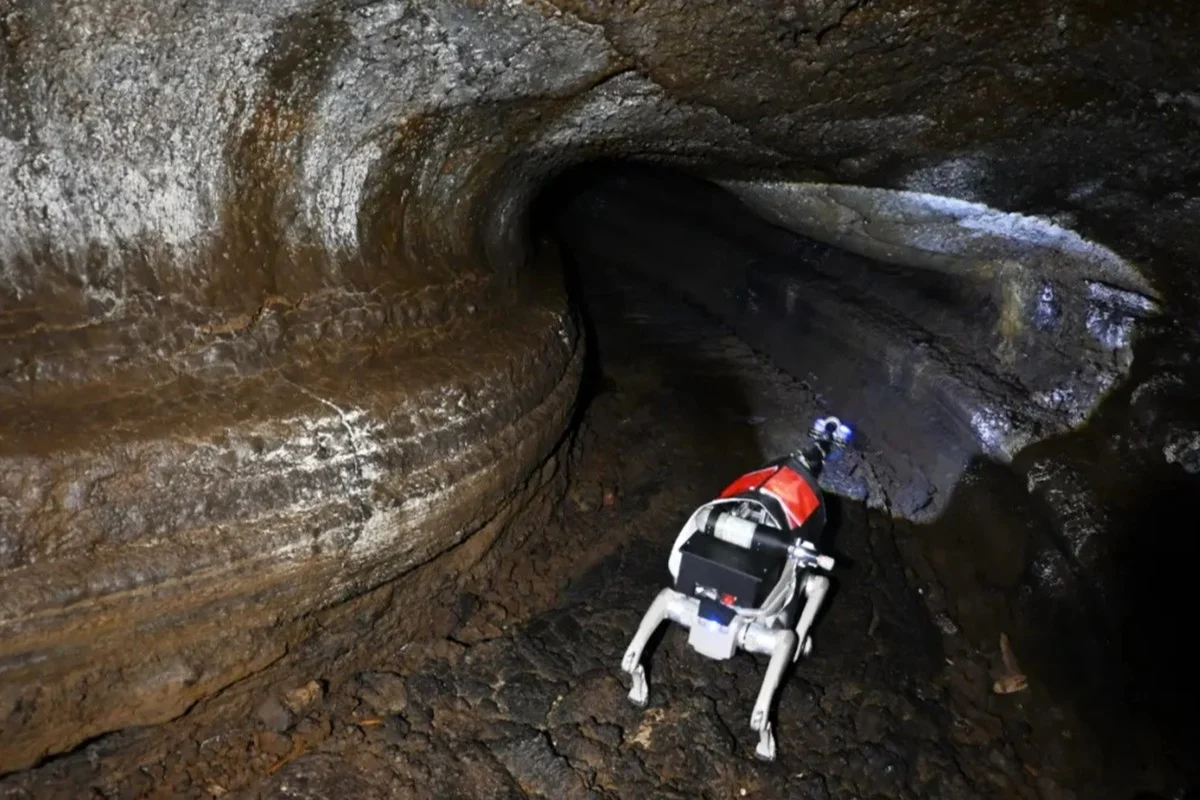Peking University says it has developed two prototypes for exploring terrain considered ideal for establishing human bases

Specialised robotic dogs such as the one seen here have been tested in a cave in northeastern China in an area that simulates the lunar underground. Photo: Handout
Chinese researchers are testing and training robotic dogs in preparation for future exploration beneath the moon’s surface, an area that is considered ideal for establishing human lunar bases.
According to a September 28 post on Peking University’s social media account, a team from the university’s school of computer science has developed two specialised robotic dogs for the exploration mission, and tested them in a cave in northeastern China.
Created by lava flows and located in a forest region near Jingbo Lake near the city of Mudanjiang in Heilongjiang province, the cave is “strikingly similar” to the lunar underground environment, according to the university post.
There, some sections suddenly narrow to a point that is impassable for research personnel, so the robotic dogs are deployed as “scouts” to reliably execute surveying tasks that the humans cannot easily accomplish.
Testing their performance in a “lunar-like lava tube environment” enabled researchers to advance the embodied intelligence technologies used in deep-space exploration, said Zhang Shanghang, a researcher at the university and the Beijing Academy of Artificial Intelligence, a non-profit AI research laboratory also known as Zhiyuan Institute.
Zhang, who led the development of the two customised robotic dogs, said these models could navigate autonomously, avoid obstacles, create maps and record high-precision 3D structures within caves.
Equipped with a lidar remote-sensing technology, the robots provided reliable spatial data for scientific research, he added.
One prototype draws inspiration from anteaters, a mammal that has evolved powerful forearms for digging. The device features a unique design combining a flexible robotic arm with a rigid mobile platform to focus on autonomous exploration and multifunctional operations in complex environments.
The other takes its name from a salamander, a type of amphibian. This prototype is a deformable, soft-wheeled robot adept at navigating challenging terrain and carrying out environmental reconnaissance.
Another Peking University scientist said the institution’s ultimate goal was to independently develop a deep-space exploration robot capable of undertaking future missions to celestial bodies such as the moon and Mars.
Advancing understanding of the underground lunar landscape with robots holds significant implications for using the moon in the future.
Lunar lava tubes or pipes – underground tunnels formed by lava flows – are considered the optimal location for establishing a crewed lunar base, offering protection from the intense radiation and extreme temperature fluctuations on the surface.
Li Jiaqi, a researcher at Peking University’s school of earth and space sciences, said temperature swings on the lunar surface could exceed 300 degrees Celsius between day and night, with lows reaching minus 183 degrees Celsius (minus 297.4 degrees Fahrenheit).
The extreme fluctuations make equipment highly susceptible to damage.
In contrast, lunar caves, where temperatures stayed relatively stable, would provide crucial support for the future deployment of exploration vehicles and even the building of crewed bases, he added.
Li said the underground volcanic lava pipes near Jingbo Lake were chosen because they were “one of the geological structures on Earth that most closely resembles the moon’s underground terrain”.
He added that the site was also China’s first teaching and practice base for the “simulated moon underground space” programme.
For similar reasons, teams from Western countries, including the United States and Spain, are actively developing and testing robotic dogs to explore lava tubes on the moon in moon-analogue environments on Earth.
China’s Chang’e 7 mission to the lunar south pole, expected to launch in about 2026, is to be equipped with a seismograph to study moonquakes and probe the lunar interior, according to scientists at the Chinese Academy of Sciences.
Working with Russia, China also plans to establish the International Lunar Research Station on the moon in the 2030s.
Source:
South China Morning Post
Written by:
Dannie Peng
